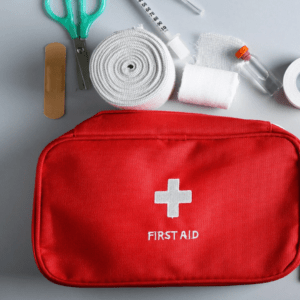
1. Burns
Burns are one of the most common kitchen injuries, often caused by hot surfaces, boiling liquids, or splattering oil.
First Aid Steps:
- Cool the Burn: Immediately place the burned area under cool (not cold) running water for 10-20 minutes. This helps to reduce swelling by pulling heat away from the skin.
- Cover the Burn: Use a sterile, non-stick bandage or clean cloth to cover the burn. Avoid using fluffy materials that might stick to the wound.
- Pain Relief: Take over-the-counter pain relievers like ibuprofen or acetaminophen to manage pain.
- Avoid Home Remedies: Do not apply butter, oil, or ice to the burn, as these can cause further damage.
- Seek Medical Attention: For severe burns, or if the burn is larger than three inches, seek medical attention immediately.
2. Cuts
Knives, graters, and other sharp kitchen tools can easily cause cuts.
First Aid Steps:
- Clean the Wound: Rinse the cut under clean, running water to remove any debris. Avoid using soap directly in the wound.
- Stop the Bleeding: Apply gentle pressure with a clean cloth or sterile bandage until the bleeding stops.
- Apply Antiseptic: Once the bleeding has stopped, apply an antiseptic cream to prevent infection.
- Bandage the Cut: Cover the cut with a sterile bandage or adhesive strip to keep it clean and protected.
- Seek Medical Attention: If the cut is deep, won’t stop bleeding, or if you suspect it needs stitches, seek medical attention.
3. Splinters
Wooden utensils or cutting boards can sometimes leave splinters in your skin.
First Aid Steps:
- Clean the Area: Wash your hands and the affected area with soap and water.
- Remove the Splinter: Use sterilized tweezers to gently pull out the splinter. If the splinter is deeply embedded, use a clean needle to carefully expose the end before pulling it out.
- Clean Again: After removal, clean the area with soap and water.
- Apply Antiseptic: Use an antiseptic cream to prevent infection and cover with a bandage if necessary.
4. Chemical Burns
Cleaning agents and other chemicals used in the kitchen can cause burns if they come into contact with skin.
First Aid Steps:
- Rinse Thoroughly: Immediately rinse the affected area under cool running water for at least 15 minutes to remove the chemical.
- Remove Contaminated Clothing: Carefully remove any clothing or jewelry that has been exposed to the chemical.
- Seek Medical Attention: For severe chemical burns or if the pain persists, seek medical attention immediately.
5. Eye Injuries
Spices, hot oil, or splashes from cutting onions can irritate or injure the eyes.
First Aid Steps:
- Rinse the Eye: Flush the eye with cool, clean water or saline solution for at least 15 minutes. Do not rub the eye.
- Remove Contact Lenses: If you wear contact lenses, remove them as soon as possible while flushing the eye.
- Seek Medical Attention: If irritation persists or if there is a severe injury, seek medical attention immediately.
6. Choking
Choking can occur if food gets lodged in the throat, blocking the airway.
First Aid Steps:
- Encourage Coughing: If the person can still breathe and talk, encourage them to cough to dislodge the object.
- Perform the Heimlich Maneuver: If the person cannot breathe, talk, or is turning blue, perform the Heimlich maneuver. Stand behind the person, place a fist above their navel, and give quick, inward and upward thrusts until the object is expelled.
- Seek Medical Attention: Even if the object is dislodged, it’s important to seek medical attention to ensure there are no further complications.
Knowing basic first aid for kitchen injuries can make a significant difference in the outcome of an accident. By staying calm and following these steps, you can effectively handle minor injuries and know when to seek professional help for more serious issues. Always keep a well-stocked first aid kit in your kitchen and take precautions to minimize risks while cooking. Happy and safe cooking!